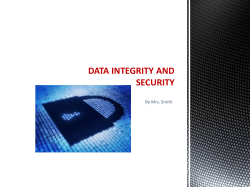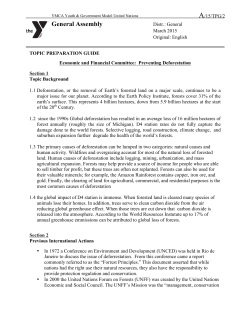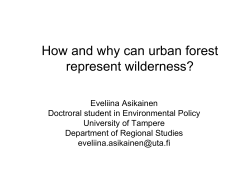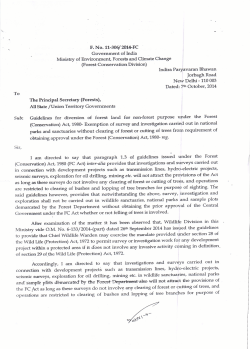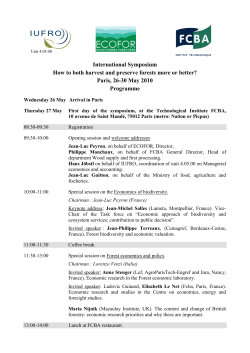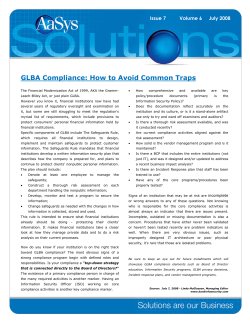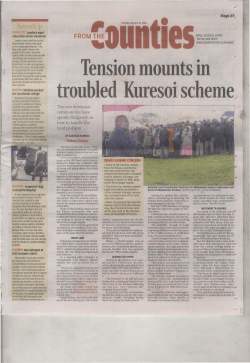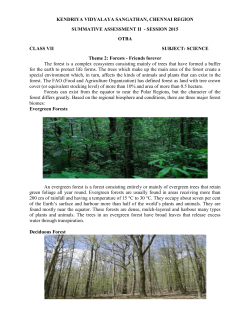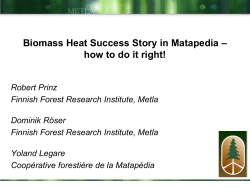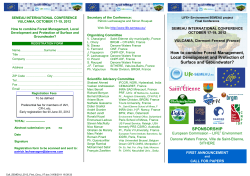
Governance, Safeguards, and Accountability: How to Ensure Climate Investments are Effective
Governance, Safeguards, and Accountability: How to Ensure Climate Investments are Effective Arvind Khare, Rights & Resources Initiative Workshop on Community Rights, Forests and Climate Change Organized by The Energy & Resources Institute and Rights & Resources Initiative With support from the UK Department for Environment, Food and Rural Affairs August 17-18 2009 | The Oberoi, New Delhi Confused yet? R-PP GtC KP CO2e BAP COP UNFCCC REDD+ NJP FCPF Offsets AFOLU Verification A/R R-PINS VER LULUCF UN-REDD FIP GFP AWG-LCA Allowances SBSTA REDD AD N2O GHG “Reddiness” R-Plans Emissions CH4 CONFUSION or DELUSION • • • Despite all acronyms the world is still dealing with the old problem – how to stop deforestation and restore degraded forests; Giving the problem more fancy names will not solve it - learning from history will; This is not the first time the global community is trying to deal with this problem – and there is no point in deluding ourselves Structure of Presentation 1. Lessons from previous interventions to reduce deforestation and degradation 2. Status of Governance in forested countries 3. Status of safeguards in New Climate initiatives 4. What would accountability demand? 5. Framework for Effectiveness 6. Questions to ponder Some lessons from history (1) 1. Previous global attempts to address deforestation have bad track record (in terms of impact) (e.g. Tropical Forest Action Plan; ITTO Objective 2000; UNFF) 2. Dominant forestry models inadequate: conservation without human rights, industrial concessions without development; social forestry without enterprises and market access • What we have NOT done: invested in developing institutions and governance, enabling local people to pursue their aspirations, forests have always been object of central, public control Some lessons from history (2) 3. 4. Establishing governance, clarifying property rights ‐ complicated and politically contentious • A national, development issue, requires action by other ministries (land, finance); far beyond capacity/competence of forest agencies usually not a national priority; • Potential investment in forest due to climate change – unprecedented –will it help deal with difficult political choices • History tells us ‐ Vested interests hard to deal with (e.g. industrial concessions, pure conservationists) The World Bank, UN, ODA, International NGOs don’t have the answer: it is up to the country government and people, yet institutions not in place for this new, national “social contract” over land and rights Some lessons from history (3) 5. Some of the major drivers of deforestation are outside of the forest sector (e.g. subsidies for agriculture, state‐sponsored deforestation) 6. Money is not the major problem, right policies supported by honest implementation can do it: • Where is “unfunded” protection taking place? Brazil (IPs’); Mexico, Guatemala, Panama, Philippines (IPs’, communities) • Where is “unfunded” restoration taking place? Nepal (communities); China, Vietnam (households) All where local rights recognized and enforced, and this is cheap $3/hectare vs $400/ha/year expected REDD payment • Governance: the situation is dire • • • • Poverty is extreme Conflicts are common Violation of human rights are commonplace Governments claim 63% of tropical world’s forests – illegal conservation, dispossession and refugees • Limited accountability, judicial redress, lack of basic services • Increasing pressure from biofuels, agriculture, population – i.e. all this getting worse – forested countries vulnerable and fragile Violent conflict common in tropical forests In the past twenty years 30 countries in the tropical regions of the world have experienced significant conflict between armed groups in forest areas. Source: D.Kaimowitz ETFRN NEWS 43/44 Weak governance common – worse in forested countries Transparency International rating1 Freedom House index2 1‐10; top score: 1 = Free, 7 = Denmark, 9.3. Not free. n 9 UNREDD 37 38 Sources: Current conflicts3 World Bank "Doing Business" ranking4 Tenure‐ related / total conflicts. Ease of doing business ranking, of 181 total. 2.6 of 10 3.5 of 7 3 / 3 119 FCPF 2.9 3.6 9 / 13 115 Both 2.9 3.6 12 / 16 116 1 Transperancy International. 2008. Corruption Perceptions Index. http://www.transparency.org/policy_research/surveys_indices/cpi 2 Freedom House. 2008. Freedom in the World. Combined Average Ratings, http://www.freedomhouse.org/template.cfm?page=410&year=2008 3 Wily, Liz A. 2008. Current conflicts around the world. Unpublished. 4 Doing Business 2009, http://www.doingbusiness.org/economyrankings/?direction=Desc&sort=1 Forested countries – low, slow economic growth • Extensive, chronic, 3.50% poverty in forest areas • “forest rich” countries doing significantly worse; • ITTO producer countries doing significantly worse Average Annual GDP Per Capita Growth 1975-2004 • “growth” located in urban, coastal areas 3.00% 2.50% 2.00% 1.50% 1.00% 0.50% 0.00% Africa Asia & Oceania L America & Caribbean -0.50% -1.00% High Forest Countries* Low Forest Countries Developing World Climate Investments: Do they address these concerns? • • • UN and World bank Bilateral Funds Carbon Markets It is important to know what safeguards these investments have to ensure the world does not repeat history The status of safeguards (1) UN‐REDD Programme • must abide by UN decisions and declarations: – UN Declaration on the Rights of Indigenous Peoples – Universal Declaration of Human Rights – International Covenant on Civil and Political Rights – International Covenant on Economic, Social and Cultural rights • But what do these mean in practice? • There are emerging “guidelines”, but no enforcement mechanisms, no grievance mechanisms at national or international levels • How to put these in place? The status of safeguards (2) World Bank FCPF * has policies and safeguards and an accountability mechanism: • OP 4.01 on environmental assessments • OP 4.1 on Indigenous Peoples • OP 4.11 on physical cultural resources • OP 4.12 on involuntary resettlement • Inspection Panel can be triggered upon “threat of harm” • Question: when and how do these apply? – To R‐PIN, R‐Plan (now RPP), Bank Project? • Many research organizations examining this issue, beginning to, or getting ready to assess implementation – CIFOR – global research program; – WRI (paper); – FPP, CIEL; Global Witness; Indigenous Peoples organizations The status of safeguards (3) Carbon Markets * Will they be any different from other markets: • What does the spectacular failure of financial markets teach us – regulations are important • Are their sufficient regulations to govern the carbon derivatives markets? • Expert believe that carbon derivative markets will be larger than credit derivative markets • “Sub‐prime carbon” credits are futures contract to deliver carbon that carry a high risk of not being fulfilled – speculation and risk of carbon bubble • Recent reports from PNG show that the risks are real The status of safeguards (4) • Today speculators do the majority of carbon trading and they will continue to dominate as carbon markets grow? – “The key differences in the emissions market, compared with other commodities markets, are that it is a politically‐generated and managed market and that the underlying [instrument] is a dematerialized allowance certificate, as opposed to a physical commodity ‐ UK Financial Service Authority – politically vulnerable to inappropriate lobbying and regulatory capture • It is imprudent to so hastily create one of the biggest new derivatives market without strong regulation and oversight – which are not in place and nature of which has not yet been determined. Adopted from “Subprime Carbon: Friends of the Earth Accountability 1. If payments are going to be made either through REDD‐ ready mechanisms or through bilateral funds, accountability demands that “readiness” should mean: • Clear, enforced, and widely supported, legal framework for forest property rights (land, forests, carbon, other ecosystem services); • Social agreement on who gets compensated; • MRV system (carbon, social and environmental) is credible and transparent at national and global levels; • Independent mechanisms for enforcement of rights and accountability exist and function at national and international levels 2. If carbon markets are being created there should be a prior agreement on nature of regulation and oversight – the main purpose of which should be to ensure respect for rights of forest communities and a fair payment to them Framework for Ensuring Effective Investment in Climate Change Adaptation & Mitigation in Forest Areas · Carbon sequestered and maintained · Rights respected · Livelihoods supported · Forests conserved OUTCOMES Questions for discussion today 1. Governments: What do your citizens expect you to put in place in terms of governance, safeguards, accountability? 2. UN‐REDD – what should they do to fulfill their obligations? • • Moving from principles/guidelines to enforceable safeguards Establishing mechanisms for accountability – national and international levels • 3. FCPF – when and how to apply their safeguards, and for what duration? • • 4. UN‐REDD proposal to create a grievance mechanism: complaints to the UN‐REDD co‐chairs and the UN country office. Is that sufficient? Apply in preparation of R‐PP, or only to Bank carbon project? If readiness leads to creation of markets –Will bank safeguards be applicable to this creation? Carbon Markets – Make haste slowly – Who? Thank you www.rightsandresources.org Arvind Khare akhare@rightsandresources.org Director of Policy and Finance Rights & Resources Initiative
© Copyright 2025

